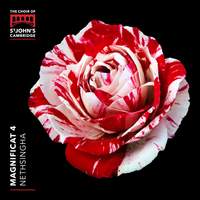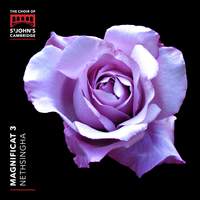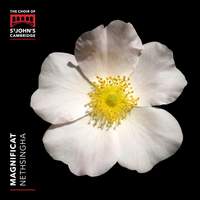Interview,
Andrew Nethsingha on his Magnificat series
David spoke to Andrew about some of the highlights on the latest instalment (including new works by Anna Semple, Jonathan Dove and Piers Connor Kennedy as well as settings by Stanford and Howells), the transition into his new role at the Abbey, and why he loves getting older...
Of Stanford’s four most famous canticle services (in G, A, B flat and C) you’ve recorded three in the course of this series, and doubtless regularly perform all four. Can you pick a favourite?
All four of them are superb. Possibly the setting in A might be my favourite, and I enjoy its links to Brahms's Symphony No. 2. The G major setting (on the new album) creates a very different sound-world from the other three. The others are very public works, but this one is intimate and private – one is eavesdropping on the young Mary’s song. In the Gloria of the Nunc Dimittis it feels as though Simeon’s soul has begun its journey to heaven; the listener is transported there too.
The Howells service in E is relatively unusual in being just for the tenors and basses of the choir. Do you make much use of upper-voice settings for trebles and altos?
Choirs like ours sing a lot of music for altos, tenors and basses. Howells in E is frequently performed in a revised version by John Buttery for that scoring. I believe we are the first choir to record the original version, which contains choral textures unlike other music I know by Howells. We don’t sing much music for trebles and altos, but we do sing settings for trebles only, such as those by Cheryl Frances-Hoad and Matthew Martin.
The accompanying notes refer to a connection between Howells’s music (especially his Te Deum Collegium Regale) and the architecture of Gloucester Cathedral. Both are of course breathtaking. But do you think that connection was really significant when Howells was writing, or is it more in the eye/ear of the beholder?
One has to be careful with this, because Howells did sometimes start a setting with one Cathedral in mind but ended up dedicating it to a different building. In the case of the Gloucester Service there are very clear links with the architecture of the building (as I wrote about in the booklet notes for Volume 1). Collegium Regale was undoubtedly written specifically for King’s – the music has great majesty but also moments of humble prayerfulness (‘We therefore pray thee’, for example) because the King’s acoustic allows the softest singing to project with great beauty.
There are two newly-written settings on this album - Piers Connor Kennedy’s Worcester Service and Anna Semple’s standalone Nunc dimittis. Do you sense any broad trends in the way contemporary composers are approaching the Anglican tradition?
In fact the album contains five settings by contemporary composers, two of which were written for St John’s. I hope they give some sense of the diverse range of current approaches to the Anglican tradition. Judith Weir’s work is written in a distinctive, understated way. The largely homophonic a cappella textures (plus some two-part writing in octaves) may contains allusions to sixteenth-century ‘Short Services’. Much of the originality is to be found in the word-setting, the detailed dynamics and the rhythms. Joanna Forbes L’Estrange writes melodies which encourage children to sing well (as Stanford had done in his day).
Piers Connor Kennedy’s prayerful setting is influenced by his personal experience of the Anglican liturgy as a singer. He generates a timelessness and a sense of space and numinosity – as do our great Cathedrals and the plainchant which has been sung in them for hundreds of years. The silence is as integral to the music as the pitches. The texture is wonderfully sonorous and well-heard.
Jonathan Dove’s setting is full of energy, joy and vivacious rhythms – with glittering organ writing. Anna Semple’s Nunc Dimittis is the most experimental music on the album – with imaginative, sometimes aleatoric textures filling the Chapel with prayer. There are some links with Jonathan Harvey’s canticles which appeared on my first disc with Signum and the St John’s imprint.
Semple’s piece is particularly noteworthy for featuring a violin obbligato. Is this something you’d expect to see more of in the future, introducing new colours into what has traditionally been an exclusive soundworld of organs and voices?
I’ve always been keen on encouraging unusual soundworlds. My commissions have included music for choir and harp, choir and cello, choir and electronics, choir and vibraphone, choir and timpani, choir with organ and trumpet. While being a huge believer in the continuity of our great Anglican choral tradition, I’m also keen to find ways to keep the liturgy and the music fresh and new. A choral service must never seem ‘routine’. Some people think it’s not appropriate to have instruments other than the organ in Anglican liturgy. That’s nonsense of course; just look at Psalm 150: ‘Praise him in the cymbals and dances: praise him upon the strings and pipe… Let every thing that hath breath praise the Lord.’

In 2023 you moved on from St John’s College to take up the post of Organist and Master of the Choristers at Westminster Abbey - what have you missed most about St John’s?
I’m privileged to have had lots of variety in my career, so this is the fifth time I’ve moved from one fine choral foundation to another one. I always miss the people who I have left behind. After Truro I missed the Father Willis Organ, but I came to love the Gloucester organ. After Gloucester I missed its acoustic, but I came to love the St John’s acoustic. Now I’m hugely enjoying becoming familiar with the innumerable wonderful attributes of Westminster Abbey. If you take a good conductor and a good choir, they combine with a unique chemistry. Once the conductor moves to a new place someone else starts to create their own chemistry, which is different.
It is a wonderful thing about recordings that one can relive various different eras, whether it’s Willcocks/King’s/1960s or Hill/Westminster Cathedral/1980s or O’Donnell/Westminster Abbey/2010s. I am now hugely enjoying starting my Nethsingha/Westminster Abbey journey, while Chris Gray is starting his own St John’s journey. I am extremely glad that my own time at St John’s, and that of my predecessors, are able to live on through recordings for those who are interested.
What have been the biggest differences on moving to the Abbey?
There are many similarities and many differences. At the Abbey I’m greatly enjoying working with many of the country’s top professional adult singers and organists, working with the amazing Abbey choristers, the architecture of the building, the opportunity to perform a much wider repertoire than I could before, the busy-ness and variety of the place, the chance to perform large-scale concerts with orchestra, and working in an institution which has daily choral worship at the heart of its existence.
Were there any particular things - items of repertoire, approaches to rehearsing, or anything else - that you picked up during your tenure at St John’s and introduced at the Abbey?
Every place you work in you learn new things. And you always learn from the people you make music with. I am enjoying growing as a musician at a fast pace here in London. Of course I bring with me, in my head, many things I learnt from my former teachers, singers, organists and buildings. As a conductor and choir-trainer you want your palette of techniques to be ever-growing. Many people don’t like getting older, but I love it because ever year I get better at my job and get to work with more amazing musicians!
I remember Semyon Bychkov writing about a recent recording he’d made with the Czech Philharmonic – he said the interpretation was not exactly what he’d initially had in mind. Neither was it a way the orchestra had played before. Instead it was something new that both parties contributed to. I love that. It’s the way we created something unique together at St John’s, and it’s the way my colleagues and I are creating something else unique at the Abbey. I hope listeners will enjoy the results!
Choir of St John's College, Cambridge, George Herbert, Andrew Nethsingha
Available Formats: CD, MP3, FLAC/ALAC/WAV, Hi-Res FLAC/ALAC/WAV, Hi-Res+ FLAC/ALAC/WAV
Choir of St John's College, Cambridge, George Herbert, Andrew Nethsingha
Available Formats: CD, MP3, FLAC/ALAC/WAV, Hi-Res FLAC/ALAC/WAV, Hi-Res+ FLAC/ALAC/WAV
Choir of St John's College, Cambridge, Glen Dempsey, Andrew Nethsingha
Available Formats: CD, MP3, FLAC/ALAC/WAV, Hi-Res FLAC/ALAC/WAV
Choir of St John's College, Cambridge, Glen Dempsey, Andrew Nethsingha
Available Formats: CD, MP3, FLAC/ALAC/WAV, Hi-Res FLAC/ALAC/WAV







